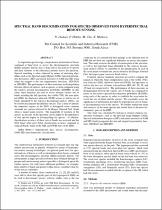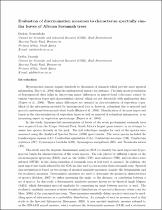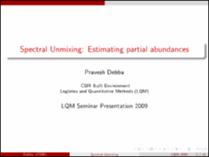JavaScript is disabled for your browser. Some features of this site may not work without it.
- ResearchSpace
- →
- Research Publications/Outputs
- →
- Conference Publications
- →
- View Item
| dc.contributor.author |
Debba, Pravesh

|
|
| dc.contributor.author |
Cho, Moses A

|
|
| dc.contributor.author |
Mathieu, Renaud SA

|
|
| dc.date.accessioned | 2010-04-13T07:58:42Z | |
| dc.date.available | 2010-04-13T07:58:42Z | |
| dc.date.issued | 2009-07 | |
| dc.identifier.citation | Debba, P., Cho, M.A. and Mathieu, R. 2009. Within- and between- class variability of spectrally similar tree species. IEEE, International Geoscience and Remote Sensing Symposium (IGARSS), Cape Town, South Africa, 12-17 July 2009, pp 1-4 | en |
| dc.identifier.isbn | 978-1-4244-3395-7 | |
| dc.identifier.uri | http://hdl.handle.net/10204/4021 | |
| dc.description | IEEE, International Geoscience and Remote Sensing Symposium (IGARSS), Cape Town, South Africa, 12-17 July 2009 | en |
| dc.description.abstract | In this paper, a comparison is made through evaluating the within and between-class species variability for the original, the first derivative and second derivative spectra. For each, the experiment was conducted (i) over the entire electromagnetic spectrum (EMS), (ii) the visible (VIS) region, (iii) the near infrared (NIR) region, (iv) the short wave infrared (SWIR) region, (v) using band selection, for example, best 10, 20, 30 and 65 bands selected, through linear stepwise discriminant analysis (vi) using sequential selection of bands, for example, every 5th, 9th, 15th, 19th or 25th band selected and (vii) spectral degradation of the spectral bands by averaging the reflectance values for every 5th, 9th, 15th, 19th or 25th band. The authors concluded that for this data set, there are important bands from the original spectra, the first and second derivative spectra and from various regions of the EMS (VIS, NIR, SWIR) that is important for species separability. Furthermore, there did not seem to be any decrease in species separability, for this data set, by degrading the spectral bands through averaging the reflectance. This implies that hyperspectral (high spectral) measurements did not prove useful in species separability compared to lower spectral resolution data. | en |
| dc.language.iso | en | en |
| dc.publisher | IEEE | en |
| dc.subject | Species separability | en |
| dc.subject | Spectrally similar | en |
| dc.subject | Spectral unmixing | en |
| dc.subject | Spectral resolution | en |
| dc.subject | Electromagnetic spectrum | en |
| dc.subject | Spectral degradation | en |
| dc.subject | Derivative spectra | en |
| dc.subject | Remote sensing | en |
| dc.subject | Geoscience | en |
| dc.title | Within- and between- class variability of spectrally similar tree species | en |
| dc.type | Conference Presentation | en |
| dc.identifier.apacitation | Debba, P., Cho, M. A., & Mathieu, R. S. (2009). Within- and between- class variability of spectrally similar tree species. IEEE. http://hdl.handle.net/10204/4021 | en_ZA |
| dc.identifier.chicagocitation | Debba, Pravesh, Moses A Cho, and Renaud SA Mathieu. "Within- and between- class variability of spectrally similar tree species." (2009): http://hdl.handle.net/10204/4021 | en_ZA |
| dc.identifier.vancouvercitation | Debba P, Cho MA, Mathieu RS, Within- and between- class variability of spectrally similar tree species; IEEE; 2009. http://hdl.handle.net/10204/4021 . | en_ZA |
| dc.identifier.ris | TY - Conference Presentation AU - Debba, Pravesh AU - Cho, Moses A AU - Mathieu, Renaud SA AB - In this paper, a comparison is made through evaluating the within and between-class species variability for the original, the first derivative and second derivative spectra. For each, the experiment was conducted (i) over the entire electromagnetic spectrum (EMS), (ii) the visible (VIS) region, (iii) the near infrared (NIR) region, (iv) the short wave infrared (SWIR) region, (v) using band selection, for example, best 10, 20, 30 and 65 bands selected, through linear stepwise discriminant analysis (vi) using sequential selection of bands, for example, every 5th, 9th, 15th, 19th or 25th band selected and (vii) spectral degradation of the spectral bands by averaging the reflectance values for every 5th, 9th, 15th, 19th or 25th band. The authors concluded that for this data set, there are important bands from the original spectra, the first and second derivative spectra and from various regions of the EMS (VIS, NIR, SWIR) that is important for species separability. Furthermore, there did not seem to be any decrease in species separability, for this data set, by degrading the spectral bands through averaging the reflectance. This implies that hyperspectral (high spectral) measurements did not prove useful in species separability compared to lower spectral resolution data. DA - 2009-07 DB - ResearchSpace DP - CSIR KW - Species separability KW - Spectrally similar KW - Spectral unmixing KW - Spectral resolution KW - Electromagnetic spectrum KW - Spectral degradation KW - Derivative spectra KW - Remote sensing KW - Geoscience LK - https://researchspace.csir.co.za PY - 2009 SM - 978-1-4244-3395-7 T1 - Within- and between- class variability of spectrally similar tree species TI - Within- and between- class variability of spectrally similar tree species UR - http://hdl.handle.net/10204/4021 ER - | en_ZA |









